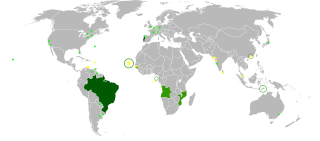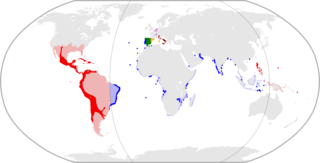
Portuguese is a western Romance language of the Indo-European language family, originating in the Iberian Peninsula of Europe. It is an official language of Portugal, Brazil, Cape Verde, Angola, Mozambique, Guinea-Bissau and São Tomé and Príncipe, while having co-official language status in East Timor, Equatorial Guinea, and Macau. A Portuguese-speaking person or nation is referred to as "Lusophone". As the result of expansion during colonial times, a cultural presence of Portuguese speakers is also found around the world. Portuguese is part of the Ibero-Romance group that evolved from several dialects of Vulgar Latin in the medieval Kingdom of Galicia and the County of Portugal, and has kept some Celtic phonology in its lexicon.

SephardicJews, also Sepharadim or Hispanic Jews, are a Jewish diaspora population associated with the Iberian Peninsula. The term, which is derived from the Hebrew Sepharad, can also refer to the Mizrahi Jews of Western Asia and North Africa, who were also influenced by Sephardic law and customs. Many Iberian Jewish exiles also later sought refuge in Mizrahi Jewish communities, resulting in integration with those communities.

The Spanish Empire, also known as the Hispanic Monarchy or the Catholic Monarchy was a colonial empire governed by Spain and its predecessor states between 1492 and 1976. One of the largest empires in history, it was, in conjunction with the Portuguese Empire, the first to usher the European Age of Discovery and achieve a global scale, controlling vast portions of the Americas, Africa, various islands in Asia and Oceania, as well as territory in other parts of Europe. It was one of the most powerful empires of the early modern period, becoming the first empire known as "the empire on which the sun never sets". It reached its maximum extent in the 18th century.

The Portugal national football team has represented Portugal in international men's football competition since 1921. The national team is controlled by the Portuguese Football Federation (FPF), the governing body for football in Portugal. Portugal's home matches are played at various stadiums throughout Portugal, and its primary training ground and technical headquarters, Cidade do Futebol, is located in Oeiras. The head coach of the team is Roberto Martínez, who replaced Fernando Santos in January 2023 following his stepping down after the 2022 World Cup, and the captain is Cristiano Ronaldo, who also holds the team records for most caps and most goals.

The Iberian Union refers to the dynastic union of the Crowns of Castile and Aragon and the Kingdom of Portugal that existed between 1580 and 1640 and brought the entire Iberian Peninsula, as well as Portuguese and Spanish overseas possessions, under the Spanish Habsburg monarchs Philip II, Philip III, and Philip IV. The union began after the Portuguese crisis of succession and the ensuing War of the Portuguese Succession, and lasted until the Portuguese Restoration War, during which the House of Braganza was established as Portugal's new ruling dynasty with the acclamation of John IV as the new King of Portugal. As a personal union, the Kingdoms of Portugal and Spain remained independent states, sharing only a single monarch.
Ephysteris is a genus of the twirler moth family (Gelechiidae). Among these, it is assigned to tribe Gnorimoschemini of the subfamily Gelechiinae. Even though it is a rather diverse and widespread group, most of these small and inconspicuous moths were overlooked by scientists until the early 20th century. Almost 90 species are known today but new ones are still being discovered.

Homoeosoma inustella is a species of snout moth in the genus Homoeosoma. It was described by Ragonot in 1884. It is found in Spain, France, Italy, Switzerland, Austria, the Czech Republic, Slovakia, Hungary, Romania, Bulgaria, North Macedonia, Ukraine, Belarus and Russia.
Ephysteris tenuisaccus is a moth of the family Gelechiidae. It is found in Russia and on Cyprus. The habitat consists of chalk steppe.
Ephysteris promptella, the ratoon shootborer, is a moth of the family Gelechiidae. It is a pantropical species, found in the warmer parts of the Old World tropics to Australia. It is widely distributed in southern Europe.
Ephysteris deserticolella is a moth of the family Gelechiidae. It is found on Cyprus and in Ukraine, the south-eastern part of the European Russia, Turkey, Iran and Afghanistan.
Ephysteris iberica is a moth of the family Gelechiidae. It was described by Povolný in 1977. It is found in Croatia, Greece, France, Spain and on Sicily and Malta. Outside of Europe, it has been recorded from Israel.
Ephysteris infirma is a moth in the family Gelechiidae. It was described by Edward Meyrick in 1912. It is found in the Democratic Republic of the Congo and South Africa (KwaZulu-Natal).
Ephysteris juvenilis is a moth in the family Gelechiidae. It was described by Edward Meyrick in 1929. It is found in Assam, India.
Ephysteris sirota is a moth in the family Gelechiidae. It was described by Edward Meyrick in 1908. It is found in the South Africa provinces of Gauteng, KwaZulu-Natal and Limpopo.
Ephysteris diminutella is a moth in the family Gelechiidae. It was described by Zeller in 1847. It is found in Spain, France, Italy, Romania, North Macedonia, Greece and Russia, as well as on Sicily. Outside of Europe, it is found in North Africa and Palestine.
Ephysteris insulella is a moth in the family Gelechiidae. It was described by Hermann von Heinemann in 1870. It is found in France, Germany, Switzerland, Italy, Bulgaria, Romania and Russia. Outside of Europe, it is found in south-eastern Kazakhstan, southern Siberia, Mongolia and China.
Ephysteris aellographa is a moth in the family Gelechiidae. It was described by Anthonie Johannes Theodorus Janse in 1960. It is found in South Africa.
Ephysteris brachyptera is a moth in the family Gelechiidae. It was described by Ole Karsholt and Klaus Siegfried Oskar Sattler in 1998. It is found on Madeira, in the north Atlantic Ocean, southwest of Portugal.
Ephysteris neosirota is a moth in the family Gelechiidae. It was described by Anthonie Johannes Theodorus Janse in 1950. It is found in Namibia.
Ephysteris parasynecta is a moth in the family Gelechiidae. It was described by Anthonie Johannes Theodorus Janse in 1963. It is found in South Africa.





